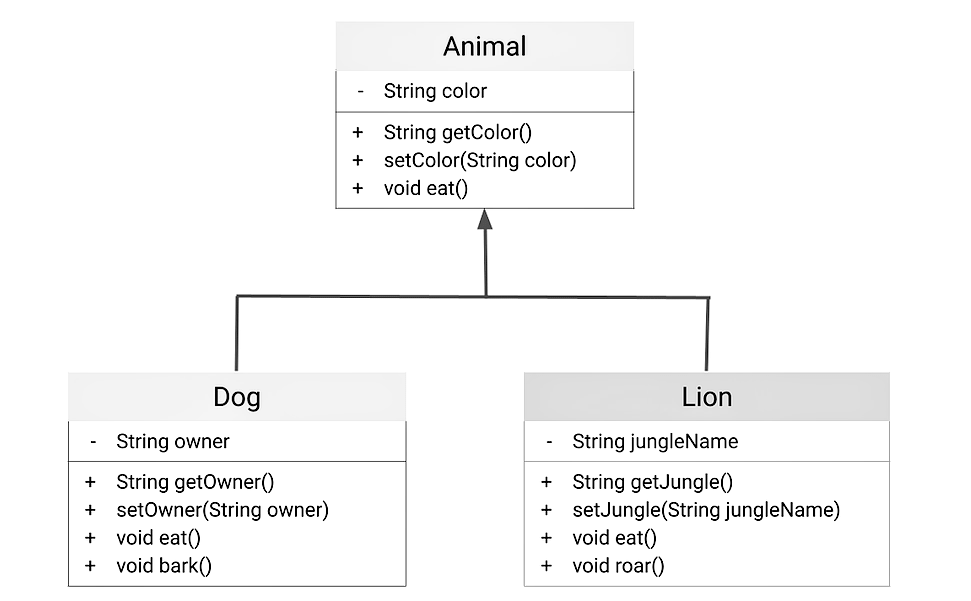
Understanding Inheritance in Programming – Made Simple | JAVA
Imagine you are building a toy car. You make one design, and then you use it to create many toy cars with small changes – maybe a new color, or a faster engine. In programming, inheritance works just like that!
What is Inheritance?
Inheritance is a feature in object-oriented programming (OOP) where one class (called a child or subclass) can get the features of another class (called a parent or superclass).
This means the child class doesn’t need to write all the code from scratch – it can reuse the code from the parent class.
Simple Example:
class Animal {
void eat() {
System.out.println("This animal eats food.");
}
}
class Dog extends Animal {
void bark() {
System.out.println("The dog barks.");
}
}
In the above example:
- Animal is the parent class.
- Dog is the child class.
- Dog gets the eat() method from Animal.
- It also has its own method bark().
Using the Class:
public class Main {
public static void main(String[] args) {
Dog myDog = new Dog();
myDog.eat(); // Inherited from Animal
myDog.bark(); // Defined in Dog
}
}
Output:
This animal eats food. The dog barks.
Cool, right? The dog class didn’t have to write the eat method again. It inherited it!
Why Use Inheritance?
- Reusability: Write once, use many times.
- Cleaner Code: Avoid repeating yourself.
- Easy to Manage: Fix or improve code in one place (parent class), and it updates everywhere.
Real-Life Analogy
Think about a family:
- A child inherits traits from parents – like eye color or height.
- In programming, a class (child) inherits methods or properties from another class (parent).
NOTE: - While inheritance is powerful, it should be used wisely. Too much inheritance can make code hard to follow. Sometimes, using composition (one class uses another) can be better. But that’s a topic for another day!
Types of Inheritance in Java – Explained Simply
Inheritance means one class can use features (like methods and variables) from another class. Java supports several types of inheritance, though not all are directly possible due to some limitations.
Let’s explore each one step by step.
1. Single Inheritance
One child class inherits from one parent class.
Example:
class Animal {
void eat() {
System.out.println("This animal eats food.");
}
}
class Dog extends Animal {
void bark() {
System.out.println("The dog barks.");
}
}
Dog inherits eat() from Animal.
2. Multilevel Inheritance
A class inherits from a class, which in turn inherits from another class.
Example:
class Animal {
void eat() {
System.out.println("This animal eats food.");
}
}
class Dog extends Animal {
void bark() {
System.out.println("The dog barks.");
}
}
class Puppy extends Dog {
void weep() {
System.out.println("The puppy weeps.");
}
}
Puppy inherits bark() from Dog and eat() from Animal.
3. Hierarchical Inheritance
Multiple child classes inherit from the same parent class.
Example:
class Animal {
void eat() {
System.out.println("This animal eats food.");
}
}
class Dog extends Animal {
void bark() {
System.out.println("The dog barks.");
}
}
class Cat extends Animal {
void meow() {
System.out.println("The cat meows.");
}
}
Dog and Cat both inherit eat() from Animal.
4. ❌ Multiple Inheritance (Not Supported with Classes)
Java does not support multiple inheritance with classes to avoid confusion (called the "Diamond Problem").
But Java does support multiple inheritance with interfaces.
5. Multiple Inheritance Using Interfaces
A class can implement multiple interfaces.
Example:
interface Printable {
void print();
}
interface Showable {
void show();
}
class Demo implements Printable, Showable {
public void print() {
System.out.println("Printing...");
}
public void show() {
System.out.println("Showing...");
}
}
Demo class gets methods from both interfaces.
Summary Table
### Summary Table: Types of Inheritance in Java | 🧬 Type | ✔️ Supported in Java | 🧪 Example | 🧱 Classes/Interfaces Used | |---------------------------|----------------------|---------------------------|----------------------------------| | Single Inheritance | ✅ Yes | `Animal → Dog` | Class to Class | | Multilevel Inheritance | ✅ Yes | `Animal → Dog → Puppy` | Class to Class | | Hierarchical Inheritance | ✅ Yes | `Animal → Dog`, `Animal → Cat` | One class, multiple subclasses | | Multiple (Class) | ❌ No | Not supported | Java doesn’t allow multiple class inheritance | | Multiple (Interface) | ✅ Yes | `Printable`, `Showable` | Interface to Class (via `implements`) |
Final Thought
Inheritance is not just a programming feature — it's a powerful concept that brings real structure and clarity to your code. Think of it as the backbone of object-oriented programming. When used the right way, it helps you write code that is clean, easy to maintain, and future-ready.
By understanding the different types of inheritance, you can build systems that are scalable (grow with time), organised (easy to manage), and efficient (less repetition, more logic). It's like creating a smart blueprint for your software — where each part knows its role, and everything fits together perfectly.
So whether you're building a simple app or a complex software system, inheritance gives you the tools to make your code stronger, smarter, and easier to understand — just like a family tree brings order to generations of relationships.
Master inheritance, and you're one big step closer to writing professional-grade code.










1 Comments
Admin SBT Reply
1 week agoNice Blog